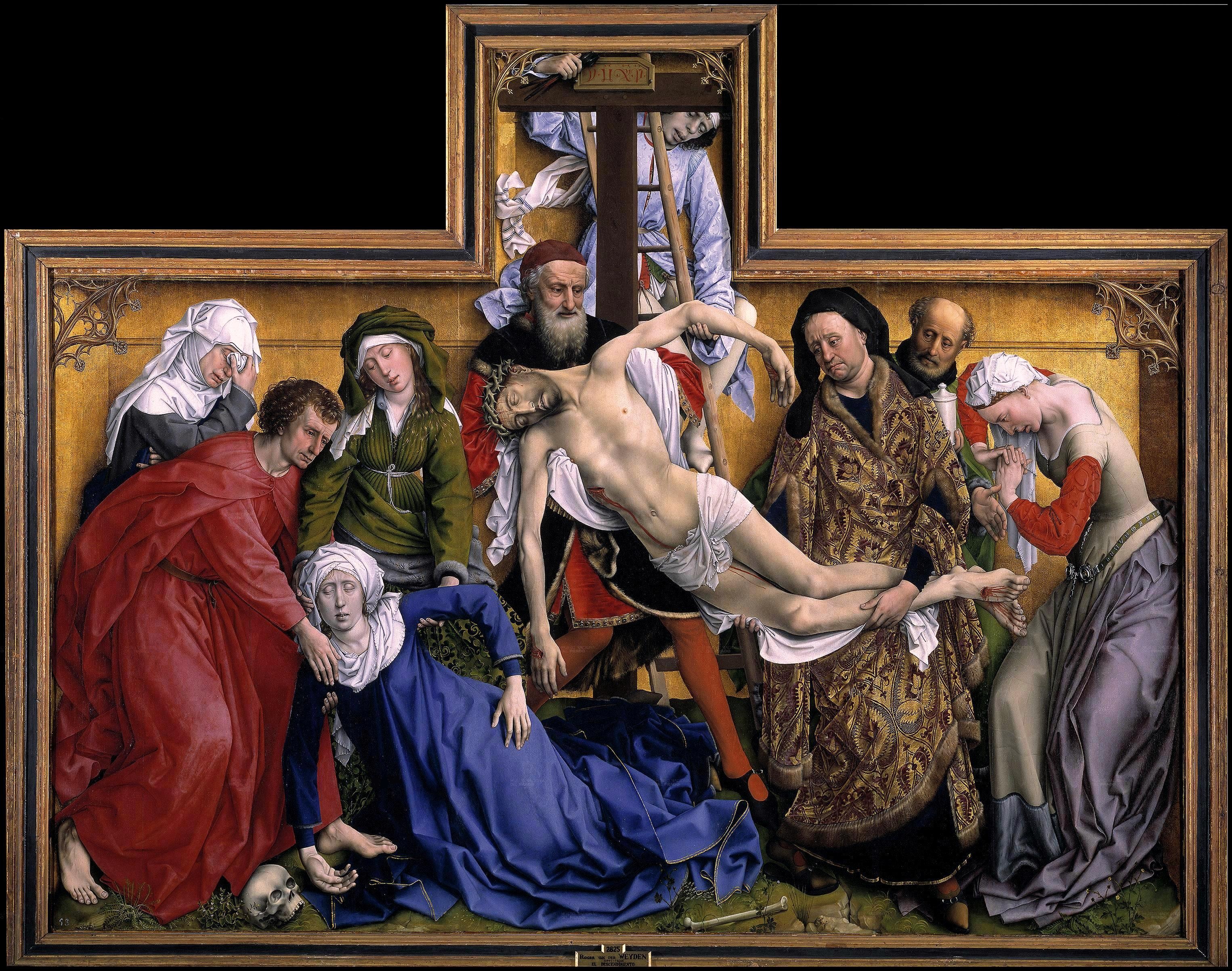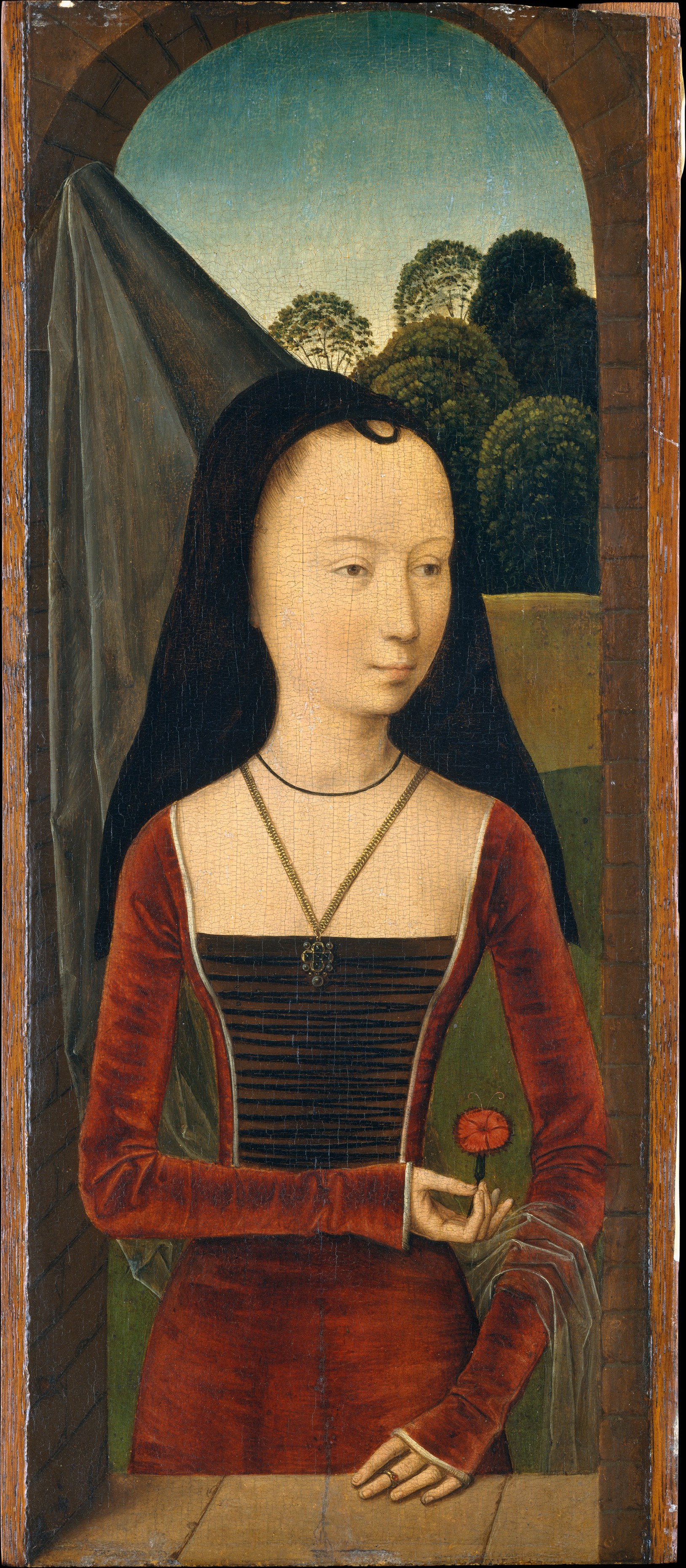|
Portrait Of A Woman (van Der Weyden)
''Portrait of a Young Woman'' (or ''Lady Wearing a Gauze Headdress'') is a painting completed between 1435–1440 by the Netherlandish artist Rogier van der Weyden. Description The sitter in this small work wears a wide, white hennin over a brown dress, which features a black-lined, v-shaped neckline. As is usual of van der Weyden's female portraits, her hands are clasped tightly in prayer, while her expression is generally humble. Unusually for a van der Weyden', she does not bow her head or gaze into the middle distance. Instead she looks directly at the viewer, creating an intimate relationship between sitter, viewer and artist,Campbell, 15 which art historian and research curator Lorne Campbell describes as "appealing and vibrant".Kemperdick, 22 The sitter has unusually bright, large and attractive blue eyes; their rendering may be considered outside of contemporary representation in that the artist did not reduce the size of the sitter's left eye to reflect the scale o ... [...More Info...] [...Related Items...] OR: [Wikipedia] [Google] [Baidu] |
Rogier Van Der Weyden
Rogier van der Weyden () or Roger de la Pasture (1399 or 140018 June 1464) was an early Netherlandish painter whose surviving works consist mainly of religious triptychs, altarpieces, and commissioned single and diptych portraits. He was highly successful in his lifetime; his paintings were exported to Italy and Spain, and he received commissions from, amongst others, Philip the Good, Netherlandish nobility, and foreign princes. By the latter half of the 15th century, he had eclipsed Jan van Eyck in popularity. However his fame lasted only until the 17th century, and largely due to changing taste, he was almost totally forgotten by the mid-18th century. His reputation was slowly rebuilt during the following 200 years; today he is known, with Robert Campin and van Eyck, as the third (by birth date) of the three great Early Flemish artists (''Vlaamse Primitieven'' or "Flemish Primitives"), and widely as the most influential Northern painter of the 15th century. Very few details of ... [...More Info...] [...Related Items...] OR: [Wikipedia] [Google] [Baidu] |
Gemäldegalerie, Berlin
The Gemäldegalerie (, ''Painting Gallery'') is an art museum in Berlin, Germany, and the museum where the main selection of paintings belonging to the Berlin State Museums (''Staatliche Museen zu Berlin'') is displayed. It was first opened in 1830, and the current building was completed in 1998. It is located in the Kulturforum museum district west of Potsdamer Platz. It holds one of the world's leading collections of European paintings from the 13th to the 18th centuries. Its collection includes masterpieces from such artists as Albrecht Dürer, Lucas Cranach, Hans Holbein, Rogier van der Weyden, Jan van Eyck, Raphael, Botticelli, Titian, Caravaggio, Peter Paul Rubens, David Teniers the Younger, Rembrandt, Johannes Vermeer, Thomas Gainsborough, Joshua Reynolds and Antonio Viviani. Collection The Gemäldegalerie prides itself on its scientific methodology in collecting and displaying art. Each room can be taken in as a single statement about one to five artists ... [...More Info...] [...Related Items...] OR: [Wikipedia] [Google] [Baidu] |
Berlin State Museums
The Berlin State Museums (german: Staatliche Museen zu Berlin) are a group of institutions in Berlin, Germany, comprising seventeen museums in five clusters, several research institutes, libraries, and supporting facilities. They are overseen by the Prussian Cultural Heritage Foundation and funded by the German federal government in collaboration with Germany's federal states. The central complex on Museum Island was added to the UNESCO list of World Heritage Sites in 1999. By 2007, the Berlin State Museums had grown into the largest complex of museums in Europe. The museum was originally founded by King Friedrich Wilhelm III of Prussia in 1823 as the Königliche Museen (in English, Royal Museums). The director-general of the Berlin State Museums is Michael Eissenhauer. Museum locations Berlin-Mitte * Museum Island ** Altes Museum: Roman and Greek Classical Antiquities ** Alte Nationalgalerie: 19th century sculptures and paintings. ** Bode-Museum: the Numismatic C ... [...More Info...] [...Related Items...] OR: [Wikipedia] [Google] [Baidu] |
Early Netherlandish Painting
Early Netherlandish painting, traditionally known as the Flemish Primitives, refers to the work of artists active in the Burgundian and Habsburg Netherlands during the 15th- and 16th-century Northern Renaissance period. It flourished especially in the cities of Bruges, Ghent, Mechelen, Leuven, Tournai and Brussels, all in present-day Belgium. The period begins approximately with Robert Campin and Jan van Eyck in the 1420s and lasts at least until the death of Gerard David in 1523,Spronk (1996), 7 although many scholars extend it to the start of the Dutch Revolt in 1566 or 1568–Max J. Friedländer's acclaimed surveys run through Pieter Bruegel the Elder. Early Netherlandish painting coincides with the Early and High Italian Renaissance, but the early period (until about 1500) is seen as an independent artistic evolution, separate from the Renaissance humanism that characterised developments in Italy. Beginning in the 1490s, as increasing numbers of Netherlandish and other Nor ... [...More Info...] [...Related Items...] OR: [Wikipedia] [Google] [Baidu] |
Hennin
The hennin (french: hennin ; possibly from Flemish nl, henninck meaning cock or rooster) was a headdress in the shape of a cone, steeple, or truncated cone worn in the Late Middle Ages by European women of the nobility. They were most common in Burgundy and France, but also elsewhere, especially at the English courts, and in Northern Europe, Hungary and Poland. They were little seen in Italy. It is unclear what styles the word ''hennin'' described at the time, though it is recorded as being used in French areas in 1428, probably before the conical style appeared. The word does not appear in English until the 19th century. The term is therefore used by some writers on costume for other female head-dresses of the period. With many characters or stories in pop culture, the Hennin is the element used to identify princesses of any kind, as well as that of courtesans or any important woman of royalty. Conical hennins These appear from about 1430 onwards, especially after the mid-c ... [...More Info...] [...Related Items...] OR: [Wikipedia] [Google] [Baidu] |
Robert Campin
Robert Campin (c. 1375 – 26 April 1444), now usually identified with the Master of Flémalle (earlier the Master of the Merode Triptych, before the discovery of three other similar panels), was the first great master of Early Netherlandish painting. While the existence of a highly successful painter called Robert Campin is relatively well documented for the period, no works can be certainly identified as by him through a signature or contemporary documentation. A group of paintings, none dated, have been long attributed to him, and a further group were once attributed to an unknown "Master of Flémalle". It is now usually thought that both groupings are by Campin, but this has been a matter of some controversy for decades. Campbell, Lorne. "Robert Campin, the Master of Flémalle and the Master of Mérode". ''The Burlington Magazine'', Volume 116, No. 860, Nov. 1974. 634-646 A corpus of work is attached to the unidentified "Master of Flémalle,"Fragments remain probably from som ... [...More Info...] [...Related Items...] OR: [Wikipedia] [Google] [Baidu] |
Paintings By Rogier Van Der Weyden
Painting is the practice of applying paint, pigment, color or other medium to a solid surface (called the "matrix" or "support"). The medium is commonly applied to the base with a brush, but other implements, such as knives, sponges, and airbrushes, can be used. In art, the term ''painting ''describes both the act and the result of the action (the final work is called "a painting"). The support for paintings includes such surfaces as walls, paper, canvas, wood, glass, lacquer, pottery, leaf, copper and concrete, and the painting may incorporate multiple other materials, including sand, clay, paper, plaster, gold leaf, and even whole objects. Painting is an important form in the visual arts, bringing in elements such as drawing, composition, gesture (as in gestural painting), narration (as in narrative art), and abstraction (as in abstract art). Paintings can be naturalistic and representational (as in still life and landscape painting), photographic, abstract, nar ... [...More Info...] [...Related Items...] OR: [Wikipedia] [Google] [Baidu] |
1430s Paintings
143 may refer to: *143 (number), a natural number *AD 143, a year of the 2nd century AD *143 BC, a year of the 2nd century BC * ''143'' (EP), a 2013 EP by Tiffany Evans * ''143'' (album), a 2015 album by Bars and Melody * ''143'' (2004 film), a 2004 Indian Telugu film * ''143'' (2022 film), a 2022 Indian Marathi film *''143'', a song by Set It Off from their 2009 EP, ''Calm Before the Storm'' *"1-4-3 (I Love You)", a 2013 song by Henry Lau *143 (West Midlands) Brigade *143 Records, record label of producer David Foster * KiYa 143 The is a four-axle B-B wheel arrangement diesel-hydraulic locomotive type operated in Japan since 2014 by West Japan Railway Company (JR West). Operations The KiYa 143 locomotives are used as self-propelled snowplough units during the winter ..., a locomotive type See also * List of highways numbered 143 * {{numberdis ... [...More Info...] [...Related Items...] OR: [Wikipedia] [Google] [Baidu] |
15th-century Portraits
The 15th century was the century which spans the Julian dates from 1 January 1401 ( MCDI) to 31 December 1500 ( MD). In Europe, the 15th century includes parts of the Late Middle Ages, the Early Renaissance, and the early modern period. Many technological, social and cultural developments of the 15th century can in retrospect be seen as heralding the "European miracle" of the following centuries. The architectural perspective, and the modern fields which are known today as banking and accounting were founded in Italy. The Hundred Years' War ended with a decisive French victory over the English in the Battle of Castillon. Financial troubles in England following the conflict resulted in the Wars of the Roses, a series of dynastic wars for the throne of England. The conflicts ended with the defeat of Richard III by Henry VII at the Battle of Bosworth Field, establishing the Tudor dynasty in the later part of the century. Constantinople, known as the capital of the world an ... [...More Info...] [...Related Items...] OR: [Wikipedia] [Google] [Baidu] |
Paintings In The Gemäldegalerie, Berlin
Painting is the practice of applying paint, pigment, color or other medium to a solid surface (called the "matrix" or "support"). The medium is commonly applied to the base with a brush, but other implements, such as knives, sponges, and airbrushes, can be used. In art, the term ''painting ''describes both the act and the result of the action (the final work is called "a painting"). The support for paintings includes such surfaces as walls, paper, canvas, wood, glass, lacquer, pottery, leaf, copper and concrete, and the painting may incorporate multiple other materials, including sand, clay, paper, plaster, gold leaf, and even whole objects. Painting is an important form in the visual arts, bringing in elements such as drawing, Composition (visual arts), composition, gesture (as in gestural painting), narrative, narration (as in narrative art), and abstraction (as in abstract art). Paintings can be naturalistic and representational (as in still life and landscape art, lands ... [...More Info...] [...Related Items...] OR: [Wikipedia] [Google] [Baidu] |
.jpg)







